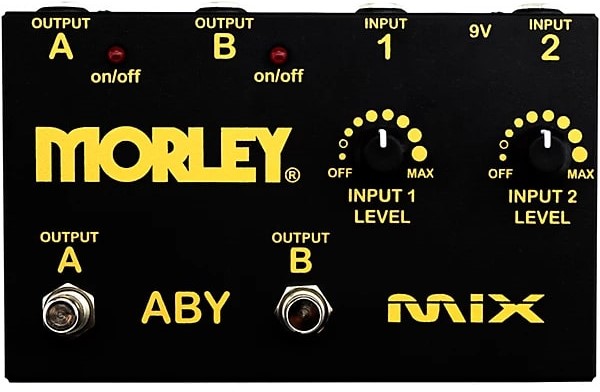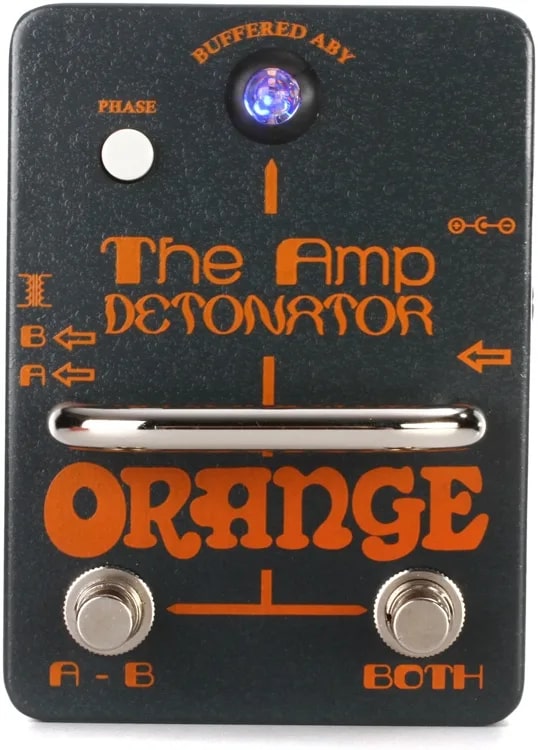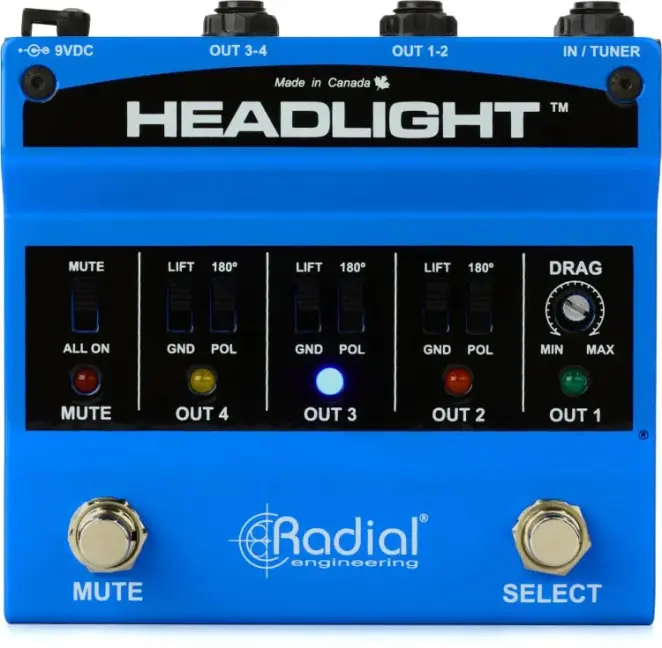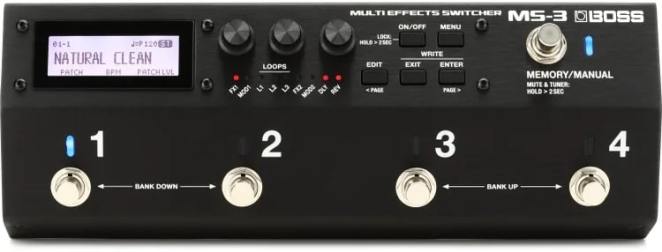When you buy through our links, we may earn an affiliate commission.
If you're a fan of guitar pedals and complex effects chains, then a guitar pedal switcher is an absolutely essential piece of kit for your pedalboard.
That said, it can be hard to know which one to choose and what to look for - given there is such a wide variety of models on the market.
Fortunately, you've just found the ultimate guide to guitar pedal switchers! We'll show you a bunch of the best guitar pedal switcher models on the market (in a range of styles).
Considering how this piece of gear can be relatively complex, we've also included a buyer's guide - where we show you the important tech specs you need to evaluate to choose the right type of pedal switcher for you.
We think the Boss MS-3 is by far one of the best pedal switchers on the market. Not only does it offer 3 switch channels, it also functions as a multi-effects pedal itself - and has 112 built-in effects!
Although this might not be exactly what you need, so make sure you check out the rest of this guide for all the other best models out there!
Quick Summary of the Best Guitar Pedal Switchers
- Morley Gold Series ABY MIX 2-button Switcher/Mixer Pedal (Best Budget Pick)
- Orange Amp Detonator Buffered A/B/Y Switcher Pedal (Best Premium Switcher)
- Radial Headlight 4-output Guitar Amp Selector Pedal (Best for Multiple Amps)
- Boss MS-3 Multi Effects Switcher (Most Versatile)
Best Guitar Pedal Switchers
If you want to expand the range of guitar tones, you can create at the click of a button - a guitar switcher is the ultimate tool. These open up a huge range of options for guitarists in terms of tone choices and mean you can instantly switch tones without needing to fiddle around with knobs on your pedal board.
Because there are several types of pedal switchers out there, we found the best for each type and included them below!
Best Budget Pedal Switcher
SPECS
- Channels: 2 (2 in, 2 out)
- Controls: On/Off (channels 1 and 2), Channel Gain (1 and 2)
- MIDI: No
- Other: Can merge signals
Coming in as the most affordable pedal switcher on this list, the Morley Gold ABY MIX-2 offers a surprising amount of versatility and customization for its low price.
This simple-looking unit offers two switchable input and output channels, which each come with their own independent volume control. This pedal is great for beginners looking to give themselves more options and some quick switching of their effects pedals.
One neat function is the ability to engage both channels at once - meaning that not only can you switch signals, but you can also combine two effects loops at once, creating beefy and rich tones.
It does not have enough range or flexibility to be at the center of a pro setup, but it's ideal for smaller rigs and experimentation.
Best Premium Switcher
SPECS
- Channels: 2 (A/B/Y)
- Controls: Phase, A/B, Both
- MIDI: No
- Other: Output buffering
You might think - "this pedal is more expensive than the Morley, but it has fewer controls?" Well, the reason for this is in the build quality and the inclusion of a pro-grade buffer circuit.
This is another simple two-channel switcher that lets you change between channels A or B (or combine the two) at the push of a button. However, it comes with a couple of nice extras that make it more suitable for pros. This is the inclusion of a phase switch (if you're having phase issues) and a buffer, meaning that your signal quality will be preserved if you're running a longer effects chain.
Sure, it would be nice to have a couple more controls, although it does everything it needs to and is very reasonably priced for the quality.
Best for Multiple Amps
SPECS
- Channels: 4
- Controls: Channel select, mute, drag, lift, phase
- MIDI: No
- Other: Input buffer, A/B/Y
The Radial Headlight is the perfect switcher pedal for players using 4 amps or effects channels. This pedal is easy to use but lets you switch up your guitar signal with a great range of versatility.
A notable feature is the inclusion of independent phase and ground control buttons for each channel, meaning that you can prevent any unwanted audio issues, buzzing, and artifacts. You can also combine two channels at once for extra beef!
Most Versatile
SPECS
- Channels: 3 loops + clean
- Controls: Effects controls, preset store, switching, memory
- MIDI: Yes
- Other: Includes multi-effects processing.
This pedal is more than just a switcher - it includes 112 built-in guitar effects, a tuner, MIDI control, preset saving, and a huge range of extra features.
If you're looking for a truly professional bit of kit to expand your creative horizons, this is definitely one pedal to investigate.
For starters, this pedal can change the sound of your guitar on its own, thanks to the built-in effects. Then, you can plug it into three external effects loops, which can be switched or combined on demand.
The preset mode lets you create a bunch of quick presets - combining both the internal effects and the loops, giving you a huge level of versatility. This means you can save multiple pedal combinations and jump between them in an instant.
The control system is also super easy to use and is intuitive, letting you dial in the perfect sound without much thought. The quiet switching technology means there are no clicks or interruptions when changing patches - meaning your performances are completely seamless!
Best Guitar Pedal Switchers Buyer’s Guide
Guitar pedal switchers are one of the more complicated pedals out there. You'll see a bunch of different types, ins and outs, control systems, and other variations.
Because they work with other pedals, you'll want to make sure that you get the right type - that will work with the rest of your gear. Besides this, you should make sure you buy a pedal switcher that meets your needs and style as a performer - as different switcher pedals are designed to perform a range of different functions.
If you're struggling to understand what you need, read through this buyer's guide! We'll explain all the important specs and considerations to help you find the perfect pedal switcher!
Number of Pedals Channels
The first spec to consider is the number of channels offered by the switcher pedal. 2-channel pedals are the lowest offering, letting you switch between two sets of pedals - these are good for basic setups but might be too limited for pros.
Alternatively, you can find pedal switchers that offer a much larger range of channels - even up to 12 or more! These are perfect for pro guitarists with complex effects rigs, although they might be too expensive and complicated for beginners.
Bypass and Buffer
A second consideration is a bypass option. This is only a small feature, but pedals with this option let you bypass all of your effects loops. This means that you can play with a completely clean signal that avoids any of your pedals.
These might not be useful for everybody, but they are handy if you want to connect a tuner pedal or like to instantly switch between dry and wet tones. You'll see the word 'true bypass' used a lot - this simply means that the bypass signal is completely clean and doesn't have any unwanted coloration on the guitar signal.
Buffers are another important thing to think about and can be a bit complex to get your head around. Essentially, an output buffer is part of a circuit that helps to step the voltage up or down. This is a more technical aspect that won't fit in this guide, but do some research on it if you have a more complex guitar pedal setup!
MIDI or Analog
A more complex consideration is whether you want your pedal to have any kind of MIDI compatibility or you are happy for it to be purely analog.
MIDI-enabled pedals let you control digital devices. For the most part, guitarists use these types of switchers to control digital effects, like processing on a DAW in a computer, like Ableton Live. Some other effects and looper pedals feature MIDI controls, so these can also be useful in that context - although that's a more specific and niche use situation.
If you're not using any MIDI effects or digital processors, then you won't need to get a MIDI pedal. This is the kind of feature that you will instantly know if you need it or not. For most setups that just involve guitar pedals, a completely analog circuit design will be perfect!
Power Supply Compatibility
For the most part, guitar pedals are all designed around the 9V power supply system. This means that they are either powered by a 9v battery or a 9v power supply.
The main thing to think about for this specification is what kind of powering setup your guitar pedals are using. If you're planning on plugging your switcher pedal into a multi-device guitar pedal power system, then make sure that the voltage and connector plugs are compatible!
Size and Portability
Most guitarists will just want a simple guitar pedal switcher that they can fit onto their pedal board. These are usually slightly larger than standard pedals and equally as portable.
However, for larger guitar setups, you might want something a bit bigger that has a larger capacity for connections. These are better for pro setups (the kind of level where you have a guitar technician touring with you), where you get more functionality and flexibility at the expense of space and weight in your setup.
Sometimes, the main patching part is a rack-mounted unit, which is then connected to a pedal controller.
Ease of Use vs Flexibility
One common trade-off with these types of peals is simplicity vs flexibility. You'll find that the pedals that are easier to use are also more limited in how you can configure their signal switches. Alternatively, more complex pedals have a wider range of configuration options.
The choice here basically comes down to how much time you want to spend learning the pedal and how complex you think you'll need your switch capability to be. If you just need to be able to switch between a couple of channels, then a basic model will be fine.
But if you want to have a more flexible setup where you can activate different pedals and change their position on the fly, you'll need to get ready to read a chunky manual!
Custom Unit For Specific Amp?
In most cases, you'll want a standalone pedal switcher that can plug into any of your guitar pedals. However, depending on what type of amp you use, sometimes you can find amp-controller pedals. These can be handy accessories that let you switch channels on your guitar amp and sometimes control built-in effects. These won't be everyone's cup of tea but do a bit of Googling to see if your amp has a control pedal, as often they are handy investments.
Frequently Asked Questions (FAQs)
What do guitar pedal switchers do?
Guitar pedal switchers are a unique type of guitar pedal. Unlike other guitar pedals, they don't actually change the guitar tone by themselves - they aren't an effect in the traditional sense. However, they do change the tone of your guitar by modifying the effects' signal flow.
Essentially, guitar switcher pedals can be used to change the combination and sequencing of guitar pedals on your board. Rather than directly affecting the sound, they choose which pedals get used in your signal chain. This means that you can use them to drastically change the tone of your guitar on the fly - as they can be used to select between different effects pedal banks.
This type of pedal is often also called a 'loop switcher' because they switch between different 'effects loops' on your board.
You can also find MIDI-enabled pedals - which provide a more extensive set of controls and can be used to control digital effects on a computer. These sometimes offer the ability of storing external control parameters - meaning you can quickly switch between different presets that you design before the show!
Why are guitar switcher pedals useful?
Using a guitar switcher pedal in your guitar setup can open up a huge range of creative options in your tone, playing, and style.
Essentially, it gives you the ability to completely change the signal chain of your guitar effects without needing to unplug and re-plug your pedals. This means that you can prepare a range of different tones using your pedals or amps and then switch through them with a tap of your foot.
This is super useful, as it means you can perform more fluidly with a wider range of guitar sounds. For pro guitarists who use a lot of different tones in a single song, these pedals are an essential accessory.
Are pedal switchers worth it?
Whether pedal switchers are worth it or not depends on a few things - your level of expertise, your budget, and how many other effects pedals you use.
If you don't use many guitar effects pedals and prefer a simple setup, then you might not get much use out of pedal switcher. You might be better off investing your money in more effects pedals first.
However, if you have complex effects chains and are a big user of guitar effects pedals, then a pedal switcher is nearly essential. These let you instantly switch between multiple pedal combinations, so you can drastically change your tone at the click of a button!
Does pedal order matter with a switcher?
Pedal order is always an important factor that should be considered when designing your effects chains. Because the effects of pedals stack up with each subsequent processor, the order you put your effects has a huge influence on the final sound.
For example, putting reverb pedals after distortions usually sounds a lot better than the other way around. This is because you are reverbing a distorted signal rather than distorting a reverbed signal.
That said, some pedal switchers let you connect one pedal to each channel, meaning that you can change the ordering from the pedal alone. Although these tend to be expensive, pro-grade pieces of equipment.
Pedal order is a bit of an art form, so make sure you look into it and experiment.
What is the guitar pedal that controls other pedals?
The guitar pedal that controls other guitar pedals is called a guitar pedal switcher. These let you change the configuration of your effects pedals using your feet.
Typically, they offer a few different effects loops that can be switched between, meaning you can prepare a range of different effects tones without needing to unplug your pedals!
A fantastic pedal switcher can make a huge difference to your creative options as a guitarist!
Conclusion
These pedals can be tricky to understand and choose - so make sure you spend as much time as you need to work out which is the right one for you.
While it is on the pricier side, we really love the Boss MS-3 - and think the price is definitely justified. This is a super powerful switchers/multi-effects pedal, which can open up unprecedented new levels of creativity in your guitar performances. You really can't fault this pedal!




